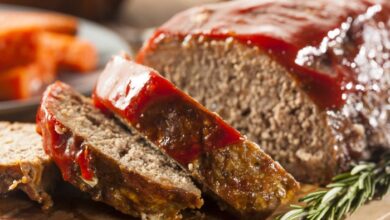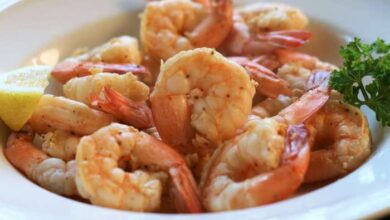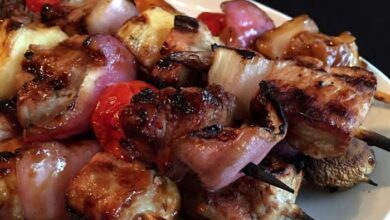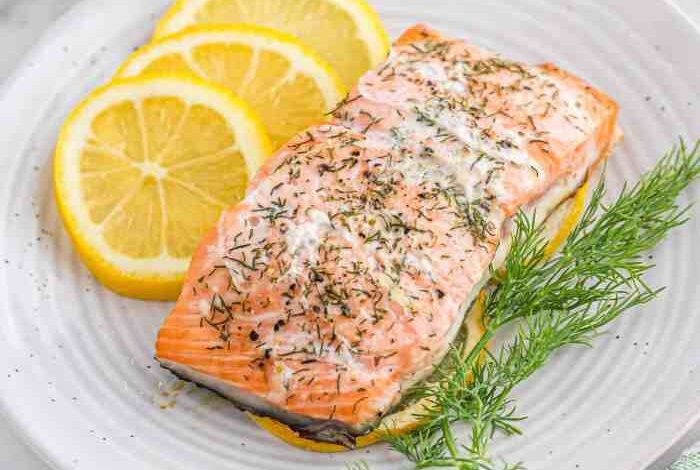
Salmon with Lemon and Dill: A Culinary Classic
Salmon with lemon and dill is a dish that transcends time and culture. This simple yet elegant combination has been enjoyed for centuries, its origins traced back to ancient culinary traditions. The interplay of flavors – the rich, fatty salmon, the bright, tangy lemon, and the fragrant dill – creates a symphony on the palate that is both satisfying and refreshing.
From humble beginnings, salmon with lemon and dill has evolved into a culinary staple, appearing on menus around the world. Its versatility allows for endless variations, each reflecting the unique culinary heritage of its origin. Whether it’s a simple pan-seared fillet or a more elaborate baked dish, the essence of this classic remains: a harmonious blend of fresh ingredients that tantalizes the taste buds.
Salmon with Lemon and Dill
The simple yet elegant combination of salmon, lemon, and dill has captivated palates for centuries, evolving into a culinary classic celebrated across the globe. This dish transcends cultural boundaries, offering a harmonious blend of flavors and textures that resonate with both seasoned chefs and home cooks alike.
Origins and History
The origins of salmon with lemon and dill can be traced back to ancient times, where both salmon and dill were staples in Scandinavian and Nordic cuisines. The use of lemon, however, emerged later, introduced through trade routes and culinary influences from the Mediterranean region.
The dish’s popularity grew throughout Europe, particularly in countries with access to fresh salmon and abundant dill. The combination of these ingredients was particularly well-suited to the region’s culinary traditions, where fresh, seasonal ingredients were highly valued.
Traditional Methods and Variations
The traditional method of preparing salmon with lemon and dill involves simply grilling or baking the fish, seasoned with salt, pepper, and fresh dill. Lemon juice is often added during cooking or served as a garnish, adding a bright, citrusy note to the dish.Variations abound, reflecting regional and personal preferences.
For example, some recipes call for poaching the salmon in a flavorful broth infused with dill and lemon, while others incorporate other herbs like parsley or tarragon.
- Grilled Salmon with Lemon and Dill:This classic preparation involves grilling salmon fillets seasoned with salt, pepper, and fresh dill. Lemon slices are often placed on top of the fish during grilling, adding a burst of citrusy flavor.
- Baked Salmon with Lemon and Dill:This variation involves baking salmon fillets in a foil packet with lemon slices, fresh dill, and a drizzle of olive oil. The heat of the oven gently cooks the salmon, creating a tender and flavorful dish.
- Poached Salmon with Lemon and Dill:This method involves poaching salmon fillets in a flavorful broth infused with dill, lemon slices, and other aromatics. The poaching process creates a delicate and moist salmon, perfect for a light and refreshing meal.
Significance in Culinary History
Salmon with lemon and dill is more than just a dish; it embodies the principles of simplicity, seasonality, and fresh ingredients that have long been cherished in culinary traditions. The dish’s enduring popularity speaks to its ability to satisfy both the palate and the soul.The dish’s significance lies in its versatility, adaptability, and enduring appeal.
It has been enjoyed for centuries, passed down through generations, and continues to be a staple in countless kitchens worldwide. Its simplicity allows for countless variations, making it a culinary canvas for creativity and personal expression.
The Ingredients
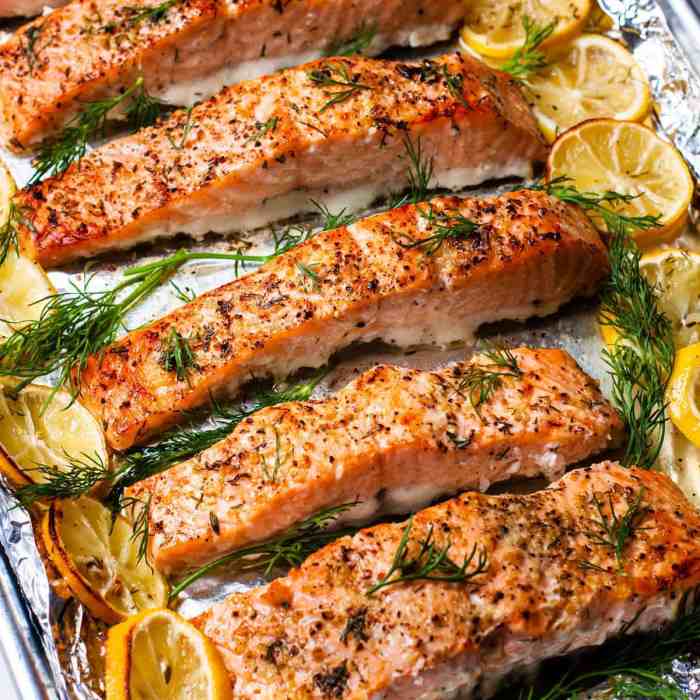
This dish is a symphony of flavors, with each ingredient playing a crucial role in creating a harmonious and delicious experience. The combination of salmon, lemon, and dill results in a dish that is both fresh and satisfying, a true testament to the power of simple yet carefully chosen ingredients.
Salmon: A Nutritional Powerhouse
Salmon is a versatile and nutritious fish that is a staple in many cuisines around the world. Its rich, oily flesh is packed with essential nutrients, including omega-3 fatty acids, protein, vitamin D, and potassium.
Omega-3 fatty acids are known for their heart-healthy benefits, while protein is essential for building and repairing tissues.
Salmon with lemon and dill is a classic for a reason – it’s light, refreshing, and perfectly complements the fish’s delicate flavor. But if you’re looking for something a bit bolder, I recommend trying a grilled tilapia with smoked paprika, like the recipe featured on Cerita Kuliner.
The smoky paprika adds a depth of flavor that’s hard to resist, and it pairs beautifully with the flaky tilapia. Of course, if you’re craving that bright, citrusy taste, you can always come back to salmon with lemon and dill – it’s always a winner!
Salmon’s unique flavor and texture make it a perfect canvas for various culinary creations. Its delicate sweetness complements a wide range of flavors, from tangy citrus to earthy herbs.
Salmon with lemon and dill is a classic for a reason – it’s light, refreshing, and perfectly balances the richness of the fish. Sometimes, though, I crave something a bit more vibrant and exciting, like a Mexican Fiesta Pasta Salad with its explosion of colors and flavors.
But when I’m back in the mood for that delicate, citrusy salmon, I know exactly where to go for inspiration.
Lemon: A Citrus Burst of Flavor
Lemon adds a bright and refreshing touch to the dish, balancing the richness of the salmon and enhancing its natural flavors. Its acidity cuts through the fat, creating a harmonious balance of flavors.
The lemon juice also helps to tenderize the salmon, making it more flavorful and juicy.
Lemon’s aroma adds a fragrant dimension to the dish, making it more appealing to the senses.
Dill: A Fragrant Herb with a Delicate Flavor
Dill, a member of the parsley family, brings a subtle, fresh, and slightly anise-like flavor to the dish. Its delicate flavor complements the salmon and lemon beautifully, adding a layer of complexity to the overall taste.
Dill’s delicate flavor is particularly well-suited to seafood dishes, as it does not overpower the natural taste of the fish.
Dill’s botanical properties are also notable. It is known for its digestive benefits and its ability to soothe nausea.
Preparation Techniques: Salmon With Lemon And Dill
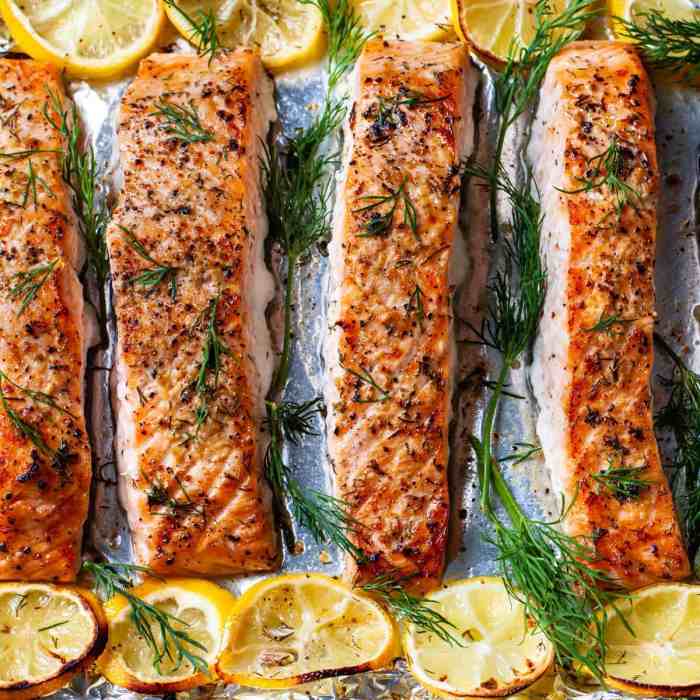
Salmon with lemon and dill is a classic dish that is incredibly versatile and can be prepared in a variety of ways. From simple pan-frying to more sophisticated grilling and baking techniques, there is a method for every preference and skill level.
Salmon with lemon and dill is a classic for a reason – it’s light, refreshing, and perfect for a summer meal. But if you’re looking for a little more oomph, consider pairing it with some grilled asparagus steak bundles.
The smoky char of the asparagus and the savory richness of the steak complement the delicate flavor of the salmon beautifully. Plus, it’s a great way to add some extra protein and vegetables to your plate.
Methods of Cooking Salmon, Salmon with lemon and dill
Here’s a step-by-step guide for preparing salmon with lemon and dill using different cooking methods:
Pan-Frying
- Pat the salmon fillets dry with paper towels.
- Season the salmon generously with salt and pepper.
- Heat a drizzle of olive oil in a non-stick pan over medium-high heat.
- Carefully place the salmon fillets in the hot pan, skin-side down.
- Cook for 3-4 minutes per side, or until the salmon is cooked through and flakes easily with a fork.
- While the salmon is cooking, zest a lemon and chop fresh dill.
- Remove the salmon from the pan and place it on a serving plate.
- Drizzle the salmon with lemon juice and sprinkle with chopped dill.
Baking
- Preheat your oven to 400°F (200°C).
- Line a baking sheet with parchment paper.
- Place the salmon fillets on the baking sheet.
- Drizzle the salmon with olive oil and season with salt, pepper, lemon zest, and chopped dill.
- Bake for 12-15 minutes, or until the salmon is cooked through and flakes easily with a fork.
Grilling
- Preheat your grill to medium-high heat.
- Pat the salmon fillets dry with paper towels.
- Season the salmon generously with salt and pepper.
- Place the salmon fillets on the grill, skin-side down.
- Grill for 3-4 minutes per side, or until the salmon is cooked through and flakes easily with a fork.
- While the salmon is grilling, zest a lemon and chop fresh dill.
- Remove the salmon from the grill and place it on a serving plate.
- Drizzle the salmon with lemon juice and sprinkle with chopped dill.
Poaching
- In a large saucepan, combine water, white wine, lemon juice, and fresh dill.
- Bring the mixture to a simmer over medium heat.
- Carefully place the salmon fillets in the poaching liquid.
- Reduce the heat to low and simmer for 5-7 minutes, or until the salmon is cooked through and flakes easily with a fork.
- Remove the salmon from the poaching liquid and place it on a serving plate.
- Drizzle the salmon with the poaching liquid and sprinkle with additional fresh dill.
Cooking Techniques Comparison
| Cooking Technique | Pros | Cons |
|---|---|---|
| Pan-Frying | Quick and easy, results in crispy skin | Can be difficult to cook evenly, may require flipping |
| Baking | Even cooking, minimal effort required | Can result in dry salmon if overcooked |
| Grilling | Adds smoky flavor, great for outdoor dining | Can be difficult to control heat, may require frequent flipping |
| Poaching | Gentle cooking method, preserves moisture | Can be time-consuming, may not develop a crispy skin |
Variations and Adaptations
The basic recipe for salmon with lemon and dill can be easily adapted to your preferences. Here are some common variations:
- Herbs:Experiment with other herbs like tarragon, parsley, or chives.
- Spices:Add a touch of heat with red pepper flakes, or a hint of earthiness with smoked paprika.
- Sauces:Enhance the flavor with a simple lemon-dill sauce, or try a more complex sauce like a beurre blanc or a creamy dill sauce.
- Vegetables:Serve the salmon with roasted vegetables like asparagus, broccoli, or Brussels sprouts.
- Sides:Pair the salmon with rice, quinoa, couscous, or a simple salad.
Serving Suggestions

Elevate your salmon with lemon and dill dinner to a culinary masterpiece by pairing it with complementary side dishes and creating a visually appealing presentation. Explore a variety of flavor combinations and enhance the dining experience with thoughtful wine pairings.
Side Dish Suggestions
Side dishes can enhance the flavor profile of your salmon with lemon and dill. Here are a few suggestions:
- Roasted Vegetables:The earthy sweetness of roasted vegetables, such as asparagus, broccoli, or Brussels sprouts, complements the delicate flavor of the salmon. Roasting brings out the natural sweetness of the vegetables and adds a smoky depth.
- Green Salad:A fresh green salad with a light vinaigrette adds a refreshing contrast to the richness of the salmon. Consider using a mix of greens like arugula, spinach, and romaine lettuce for a more vibrant salad.
- Creamy Risotto:The creamy texture of risotto pairs well with the delicate flavor of salmon. You can add a touch of lemon zest or dill to the risotto for an even more harmonious combination.
- Herbed Couscous:The fluffy texture of couscous absorbs the flavors of the lemon and dill sauce, creating a delicious accompaniment.
Plating and Presentation
Presentation plays a crucial role in enhancing the dining experience. Here are some ideas for plating your salmon with lemon and dill:
- Simple and Elegant:Place the salmon fillet on a bed of creamy risotto, garnished with fresh dill sprigs and a squeeze of lemon juice. This simple presentation allows the flavors of the salmon to shine through.
- Rustic Charm:Serve the salmon on a bed of roasted vegetables, drizzled with a lemon-dill sauce and sprinkled with toasted pine nuts. This rustic presentation adds a touch of warmth and comfort to the dish.
- Modern Minimalism:Arrange the salmon fillet on a plate with a side of green salad and a small bowl of lemon-dill sauce. This minimalist presentation emphasizes the clean and simple flavors of the dish.
Wine Pairings
Wine pairings can enhance the flavors of your salmon with lemon and dill. Here are some suggestions:
- Dry White Wine:A dry white wine like Sauvignon Blanc or Pinot Grigio complements the acidity of the lemon and dill sauce.
- Rosé Wine:A dry rosé wine, with its refreshing acidity and delicate fruit notes, can also pair well with salmon.
- Light-Bodied Red Wine:A light-bodied red wine like Pinot Noir or Gamay can also be a good match, as its subtle tannins will not overpower the delicate flavors of the salmon.
Cultural Influences
Salmon with lemon and dill, a seemingly simple dish, has roots in diverse culinary traditions around the world. Its widespread appeal speaks to the universal appreciation for fresh, flavorful ingredients and the enduring power of culinary ingenuity.
Regional Variations
Different cultures have embraced this dish, adapting it to their unique tastes and ingredients. For example, in Scandinavian cuisine, salmon with lemon and dill is a staple, often served with boiled potatoes and a creamy sauce. This version emphasizes the clean, fresh flavors of the ingredients, reflecting the region’s focus on simplicity and seasonality.
In Mediterranean cuisine, salmon with lemon and dill takes on a more vibrant character. The addition of olives, capers, and tomatoes brings a burst of Mediterranean flavors, while the use of olive oil adds richness and depth. This interpretation reflects the region’s emphasis on bold flavors and the use of fresh, local ingredients.
Cultural Significance
The dish’s cultural significance varies depending on the region. In Scandinavia, salmon with lemon and dill is often associated with special occasions, reflecting the importance of fresh salmon in the region’s cultural heritage. The dish is also seen as a symbol of the region’s natural beauty and abundance.In the United States, salmon with lemon and dill is a popular choice for casual dining, often served with roasted vegetables or a side of rice.
The dish’s versatility and ease of preparation make it a favorite for busy families and individuals alike.
Key Ingredients and Techniques
The key ingredients and techniques that distinguish different cultural approaches to preparing salmon with lemon and dill include:
- The type of salmon used: While Atlantic salmon is commonly used in many regions, other types, such as Pacific salmon or sockeye salmon, are popular in different parts of the world. Each type of salmon has a unique flavor profile and texture, which influences the overall taste of the dish.
- The use of herbs and spices: While lemon and dill are the primary seasonings, different cultures often incorporate additional herbs and spices to enhance the flavor of the dish. For example, Scandinavian cuisine might include fresh chives or tarragon, while Mediterranean cuisine might use oregano, thyme, or rosemary.
- The cooking method: Salmon with lemon and dill can be prepared in various ways, including baking, grilling, poaching, or pan-frying. Each cooking method results in a different texture and flavor profile.
- The accompanying ingredients: The choice of side dishes varies depending on the cultural context. In Scandinavia, boiled potatoes or a creamy sauce are common accompaniments, while Mediterranean cuisine might feature roasted vegetables, couscous, or a salad with olives and feta cheese.

